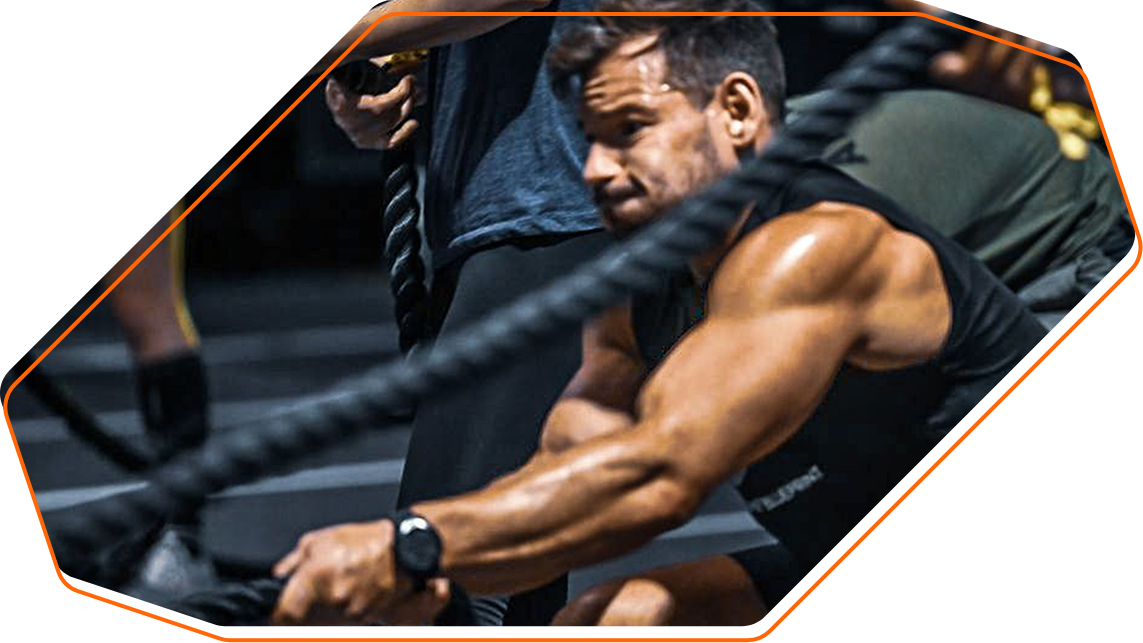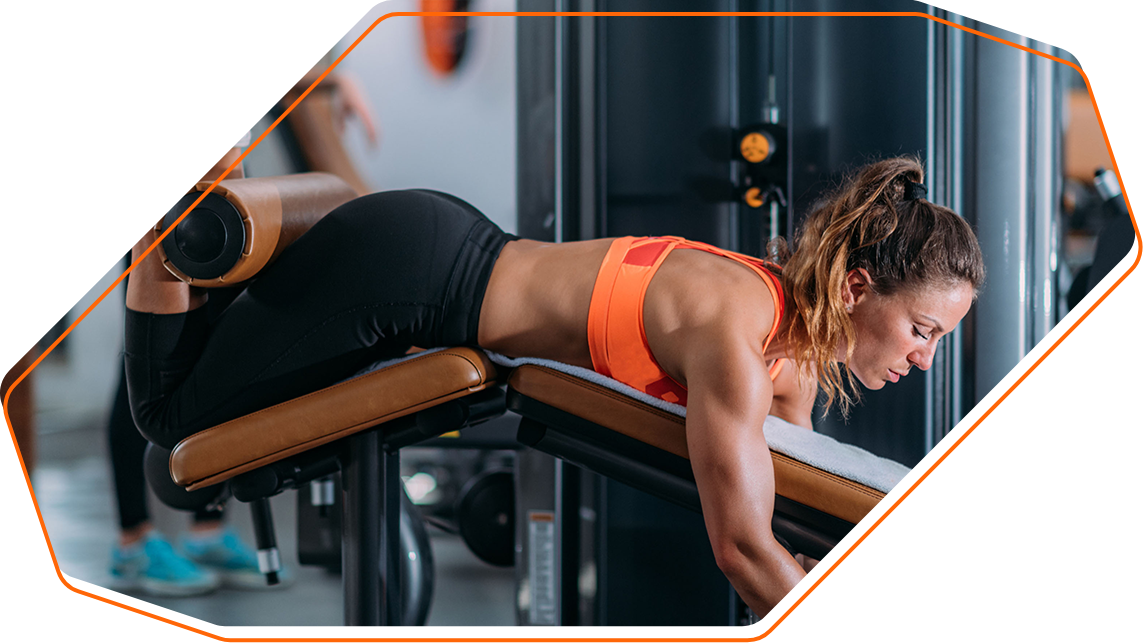HOW TO TRAIN FOR HYROX
HYROX has become a regular event within the MBP community calendar, globally! Our Coaching Team and many of our community continue to qualify for the World Championships, and regularly score podium finishes. So what’s the secret to HYROX success? Here we’ll share our tried and tested expertise to see you excel in the HYROX World!
The HYROX event is made up of 8 x 1km runs and 8 x functional workout stations [SkiErg, Sled Push, Sled Pull, Burpee Broad Jumps, Rowing, Famers Carries, Sandbag Walking Lunges and Wall Balls]. The goal is to complete the full workout in the fastest time possible – a challenge that has become mildly addictive and competitive around the world.
HYROX looks simple enough on paper, but the dark horse that will catch you up is the volume, and therefore your resistance to fatigue as you work through each station. The event requires strength, cardiovascular fitness/running and endurance in equal measure. Whilst the skill of the specific movements is key, these certainly shouldn’t be the only exercises within your training if your goal is to complete the race unbroken. There is no such thing as a fast-track podium spot, but put the hard yards into your training and you’ll be ready to perform come race day!
—
Don’t just cycle through the stations of work
HYROX relies on strength, power endurance and aerobic capacity. The principles of strength and athletic development don’t change because 8 exercises have been grouped together and a sport made out of them. To develop a body and engine that can excel within the demands of HYROX, you need to:
—
1. Develop your ability to produce force
Ensure you’re incorporating all of the following movement patterns into your training:
Hinge
Squat
Lunge
Push
Pull
Drag
Carry
Jump
—
2. Develop your strength
Progressively train all of the above patterns.
—
3. Develop your capacity to work
Energy system work and working under accumulative fatigue is key within your prep – if you struggle to programme this yourself, seek help from a coach.
—
4. Develop your running resilience
Depending on your baseline this may start with increasing your volume, before incorporating ‘compromised running’ (under fatigue).
How to master the HYROX Ski & Row
The stations make up 50% of the HYROX race, so knowing how to be a savage and how to pace each of them is key to cut your time. The 2 Ergs in HYROX are the Ski and the Row. The SkiErg is your first station and can help you accelerate away from your rivals in the opening 08:00-10:00 of the race – 𝘪𝘧 you know your pacing and want to push early on. The Rower comes right where fatigue is accumulating – Station 5 to be precise – where you will have sat at lactate threshold for some time, and will be now in the make-or-break part of your race.
—
How to prepare:
Composure is probably the least spoken about but most effective trait to take into your HYROX race. Composure comes from having confidence in your ability to endure, and to perform each of the movements. When it comes to the Ergs, your fail-safe way of building HYROX-specific capacity is to train and practice in 3 ways:
—
#1 Going long
Long interval work – Try 8 x 1km @ lactate threshold (2:00 rest between efforts)
Long continuous work – Try 30:00 for distance
—
#Mixed exposure
Try 500m Ski + 500m Run + 500m Row – Rolling for 30:00
Try 1km/800m Erg + Max reps of a non-Erg station in a 6:00 ON / 1:30 OFF time domain – Rolling for 30:00 (4 rounds)
—
#Going hard
Power – Try 10 x 125m @ RPE9 (1:00 rest between efforts)
Power endurance – Try 15 x 1:00 @ RPE8 (1:00 rest between efforts)
—
Lock these 3 in and your ability to stay efficient and controlled at your top end will set you apart from the rest of the field!
Mastering the HYROX Sled
A lot of HYROX’ers will feel comfortable with the running, but become well and truly unstuck when faced with the 2 heavy/awkward stations within the race.
—
The sled is something that relies on 2 things;
– Your ability as an athlete to couple rhythm and force into one
– Your ability to get your body into a mechanically advantageous position
—
You’ll see people get stuck on both and whilst it may seem pretty obvious when looking on (“𝘩𝘦 𝘫𝘶𝘴𝘵 𝘯𝘦𝘦𝘥𝘴 𝘵𝘰 𝘨𝘦𝘵 𝘭𝘰𝘸𝘦𝘳”) – it’s not quite as simple. When someone is trying to produce force under fatigue, their body will go to its default position. If not trained, exposed or developed by building general strength through the big patterns, that default position won’t be one the body can access power from.
—
How to build your Sled performance at HYROX:
1. Respect the development of athletic qualities; strength, speed and power. Build them over time through movements such as the deadlift, box squat, lunge, pendlay row, sprinting and jumping.
2. Once you’ve built that foundation, LAYER ON more specificity within your training. Incorporate specific skill work when fresh and when under fatigue.
—
Example:
#1 Speed/power
10m Sled Push as heavy/fast as possible – efforts in <20s
5 rounds (rest either for time or by heart rate – e.g. <110bpm)
—
20s Max distance Strict Rope Sled Pull
20s Max distance Reverse Sled Drag
3 rounds @ category weight (1:20 rest between rounds)
—
#2 Work capacity/under fatigue:
20s Standing BikeErg @ RPE9 (heavy damper)
1:00 Bodyweight Alternating Jump Lunge
2:00 BikeErg/Run @ RPE1-3 (recovery pacing)
4 rounds
—
25m Sled Push @ category weight
25m Sled Pull @ category weight
4 rounds (work:rest @ 2:1)
—
If you really want to excel in HYROX, this is how you’ll sharpen the sword.
Compromised running is essentially the descriptive of a HYROX race. Your ability to repeatedly run after accumulating fatigue will dictate your performance across the event. Different stations in HYROX will see you accumulate more fatigue through your legs than others – the Rowing, Sled Push and Burpee Broad Jumps will have an all in all higher cost than the Sled Pull and SkiErg. Compromised running is nothing fancy, it is simply running on tired legs – so as complicated as people might make it, it really is very simple.
—
In a HYROX-specific training session, this would look like: Run-Station-Run – here we are placing the bias on the running component (be it pace-driven or station-driven) to create higher levels of fatigue for the second run.
—
Lock in these 3 things within your HYROX training to make sure station 4 onwards isn’t your handbrake..
#Ensure your running base is high
Do this by increasing your run exposure at the start of your training block, before shifting into more of a mixed-modal style format.
—
#Respect the stations
Don’t ruin your runs by sending the functional fitness stations. You’ll pay more trying to recover from high RPE bouts, which will impact your ability to sustain pace on both the Ergs and in the runs. Know your pacing and stick to it.
—
#Enough exposure
You need to be prepared to push race intensity within your training, in progressive blocks that will let you experience accumulative fatigue so come race day you won’t be stopped in your tracks by lactate.
—
Here are some example sessions inspired by our event-specific programme The HYROX Blueprint™️:
1. Run heavy
500m Run @ race pace +20-40s
–
[Then 2 continuous rounds of]
25m Sled Push < category weight / RPE7-8
20 x Burpee Dumbbell Deadlift @ 25/15kg DBs
25m Farmers Carry @ heavier than category weight
–
500m Run @ race pace -10-15s
–
2 rounds, rest 2 minutes between rounds
—
2. Action stations
2 x 15:00 AMRAP;
–
A1]
400m Row/Ski @ 80-90% MHR
1.5km Run @ race pace +10-15s
400m Row/Ski @ 80-90% MHR
[Rest 5:00]
–
A2]
0:30/1:00 Continuous Jump Lunge @ BW
25m Sled Push @ BW
200m Run @ hard effort
25m Sandbag Carry @ .5/.75xBW
800m Run @ recovery pacing

Need Further Support?
The HYROX Blueprint™ is our all-encompassing training plan that will get you in the best physical shape to perform come race day! There is no such thing as a fast-track podium spot, but put the hard yards into your training and we’ll ensure you’re ready to perform – whatever your division.

About The HYROX Blueprint™
The programme will provide you with everything you need to get race-ready in 10 weeks; from running performance to HYROX-specific strength work. It includes 3 run-based sessions and 2 strength sessions each week for 10 weeks, designed to see you build strength, speed, skill and efficiency. The final week of the programme is a taper week to ensure you’re fresh, primed and ready to go ahead of your event!


